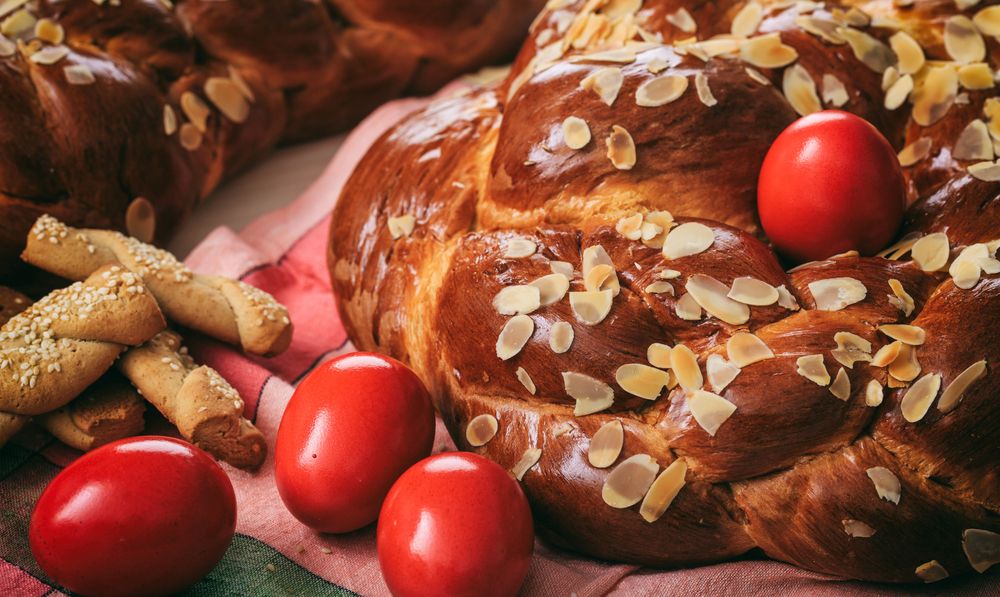
For Cretans, Easter is a time of great celebration, marked by a rich array of traditional foods and delights that reflect the island’s deep-rooted cultural and religious heritage. The Easter festivities in Crete are not only about religious observance but also about indulging in a variety of delicious dishes that bring families and communities together. Here are some of the most famous foods and delights enjoyed during the Easter holidays in Crete.
Tsoureki
Tsoureki is a traditional Greek sweet bread that is especially popular during Easter. This braided bread is flavored with mahleb, mastic, and orange zest, giving it a distinctive aroma and taste. Tsoureki is often adorned with red-dyed eggs, symbolizing the blood of Christ and new life. This bread is typically enjoyed on Easter Sunday, either on its own or with a spread of butter and honey.
Red-Dyed Eggs
Easter eggs in Crete are traditionally dyed red, representing the blood of Christ. The eggs are prepared on Holy Thursday and are a central part of the Easter celebration. On Easter Sunday, a popular custom involves cracking the red eggs against each other while saying “Christos Anesti” (Christ is Risen) and responding with “Alithos Anesti” (Truly He is Risen). The egg that remains uncracked is considered a symbol of good luck.
Magiritsa
Magiritsa is a traditional Greek Easter soup made from lamb offal, rice, and a variety of herbs, typically eaten after the midnight church service on Holy Saturday. This dish helps break the Lenten fast and prepares the stomach for the rich foods consumed on Easter Sunday. The soup is flavored with lemon and thickened with an egg-lemon sauce called avgolemono, giving it a creamy texture and tangy taste.
Lamb or Goat on the Spit
The centerpiece of the Easter Sunday meal in Crete is lamb or goat roasted on a spit. This tradition symbolizes the sacrifice of Christ, the Lamb of God. The preparation involves marinating the meat with olive oil, lemon, garlic, and various herbs. The lamb or goat is then slowly roasted over an open flame, resulting in tender, flavorful meat with crispy skin. This dish is typically served with a variety of side dishes, including roasted potatoes, fresh salads, and bread.
Kalitsounia
Kalitsounia are small, sweet cheese pies that are a Cretan specialty, especially during Easter. These pastries are made with a soft dough filled with mizithra cheese, a type of fresh, soft cheese. The pies are often flavored with cinnamon and honey, and they can be either baked or fried. Kalitsounia are enjoyed as a dessert or a sweet snack throughout the Easter celebrations.
Cretan Easter Cookies (Koulourakia)
Koulourakia are traditional Greek cookies made for Easter. These butter-based cookies are flavored with vanilla or orange and are often twisted into braids or shapes before being baked. They have a slightly crispy texture and are perfect for dunking in coffee or tea. Koulourakia are typically made on Holy Thursday and enjoyed throughout the Easter weekend.
Conclusion
Easter in Crete is a time of joyous celebration, filled with traditional foods that bring together family and friends. The sweet aromas of tsoureki and kalitsounia complement the savory flavors of magiritsa and roasted lamb, showcasing Cretan Easter’s rich culinary heritage and love for good food. These traditions not only enhance the festive spirit but also strengthen community bonds and faith. Visitors are warmly welcomed to join locals in enjoying these recipes, experiencing the island’s hospitality and culinary delights firsthand.





